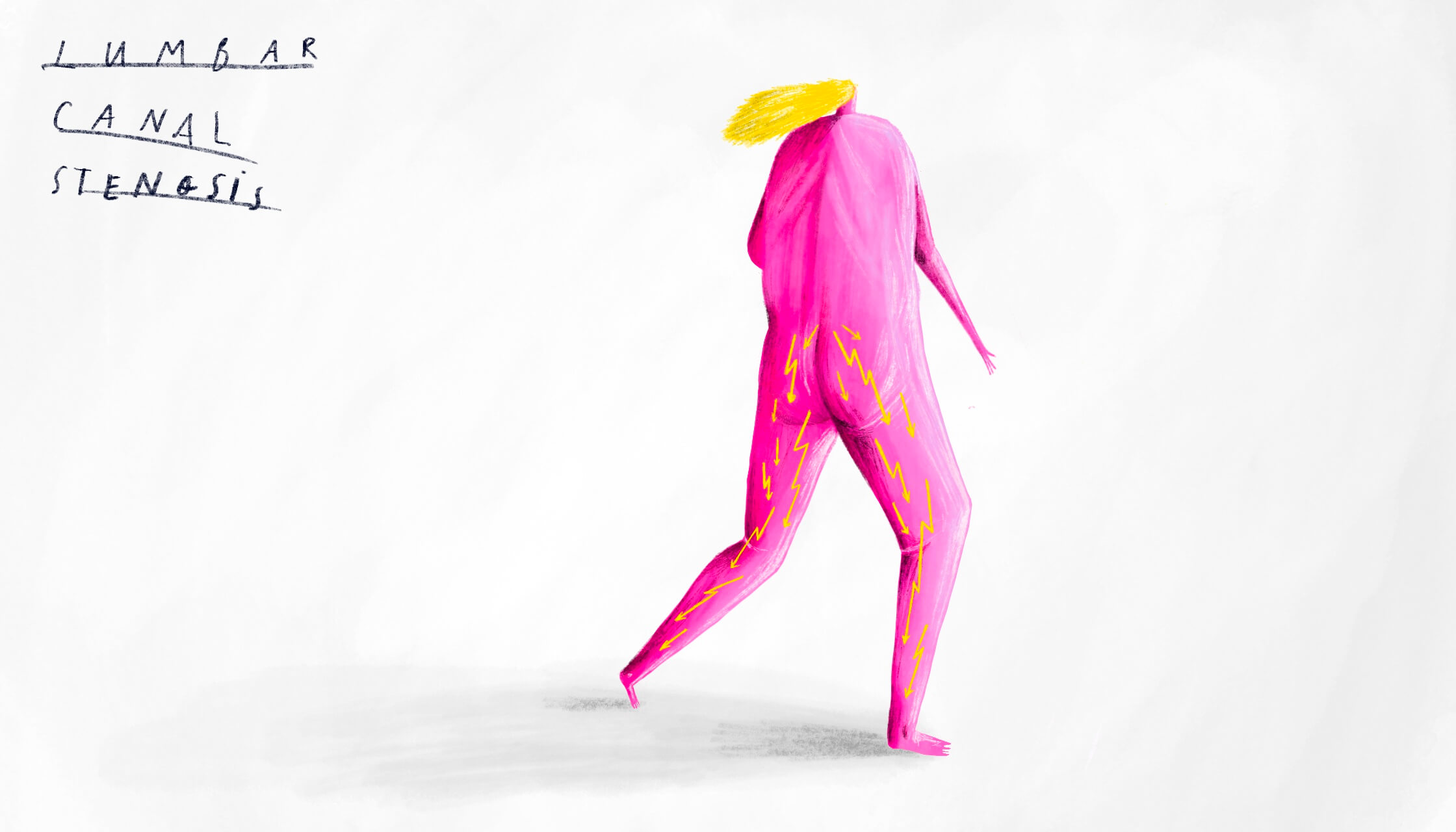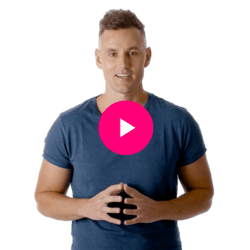Lumbar canal stenosis
or narrowing of the spinal canal in the lower back

Neurosurgeon Brisbane
Lumbar canal stenosis key points
- Lumbar canal stenosis is narrowing of the spinal canal in the lower back and caused by arthritis in the spine
- This feels like a pain or ache in the legs and is most noticeable when walking around
- There are two pathways of treatment, surgical and non-surgical.
- If you want a long term definitive treatment, keyhole surgery is very effective.
Stenosis leg pain
What is it?
Spinal canal stenosis is caused by arthritis in the spine.
Arthritis can be compared to a callus on your hand, which with force and friction on your hand, tends to thicken up. Likewise, with the force of gravity and spinal movement over years, the bones, disc and ligament tissues tend to thicken up.
It is this excess tissue that encroaches on and eventually compresses nerves running down through the spinal canal.

Spinal surgeon Brisbane
Lumbar basically means ‘lower back’. Canal refers to the main tunnel running down the middle of the spinal bones from the head to your tailbone. Stenosis means narrowing.
So, lumbar canal stenosis refers to narrowing of the spinal canal in the lower back. The spinal canal in the lower back contains a bunch of nerves. The spinal cord itself is not found down at the level of your lower back. The spinal cord actually ends about ⅔ of the way down your spine. Therefore lumbar canal stenosis only ever causes compression or jamming of these nerves, and the clinical condition this causes is called neurogenic claudication.

Spinal surgeon Brisbane
Is it common, do other people get it?
Lumbar canal stenosis causing neurogenic claudication or sciatica is very common. It is more common the older one gets. If you have lumbar canal stenosis this does not necessarily mean there is an overall problem with your spine.
I operate on close to 4 cases per week with lumbar canal stenosis.
What are the symptoms of lumbar canal stenosis?
Lumbar canal stenosis gives rise to a condition called neurogenic claudication. This feels like a pain or ache in the legs, and is most noticeable when walking around. Patients often find that leaning on a shopping trolley or having a rest by sitting down helps relieve the pain and discomfort. This is because the act of bending forward actually helps to open up space in the spine and eases the compression, and therefore the symptoms.
One thing to note is that many people with lumbar canal stenosis have no symptoms whatsoever. This is quite normal to have narrowing without it causing you symptoms. It is usually perfectly safe.
This is not a dangerous condition. It can cause symptoms that really affect your quality of life, and it can significantly reduce your mobility, but once treated you often return close to normal, if not completely. It won’t permanently paralyse you.
By far the most common cause is wear and tear, also called arthritic changes. Arthritis can be compared to a callus on your hand, which with force and friction on your hand, tends to thicken up. Likewise, with the force of gravity and spinal movement over years, the bones, disc and ligament tissues tend to thicken up. It is this excess tissue that encroaches on and eventually compresses the spinal nerves.
It is not genetic. Everybody gets some degree of arthritis as they get older. It’s just that some get it more than others for some reason. You may be lucky and have a great genetic bloodline whereby your spine responds to gravity and movement over the years very well without much wear and tear, but other than this there is no genetic reason why you did or did not get lumbar canal stenosis.
Stenosis of the spinal canal can occur at any level in the spine but it most commonly occurs in the lumbar spine. It occurs second most commonly in the cervical spine, causing a condition called cervical myelopathy. The thoracic spine is almost never involved.
The diagnosis is very important. Getting it right can mean the difference between successful treatment and failure. Just because you have lumbar canal stenosis doesn’t automatically mean it is the cause of your symptoms.
My job as a spine surgeon is to try to match any symptoms you may have with what I see on your scan and find on your examination. If there is a good match between all three then you have a very good chance of successful treatment. If there is not a good match, then this usually means there is something going on. It is literally detective work.
As you can see, this process is vital for avoiding unnecessary treatment including unnecessary surgery.
I have seen a lot of unnecessary spine surgery in Australia because this detective work was incomplete.
Lumbar canal stenosis treatment in Brisbane
How is it treated?
There are two pathways of treatment, surgical and non-surgical. Which of these you should choose depends on one thing:
Your assessment of your quality of life
If you’re ok, can move around freely and are not in too much discomfort then choosing injections, physiotherapy or other therapy is not a problem.
However, lumbar canal stenosis is also very simple to treat with keyhole surgery and can rapidly improve your quality of life with just one procedure that is usually lifelong. If you are struggling then you don’t need to be a soldier, as modern keyhole surgical techniques make this a safe and effective procedure.
Lumbar canal stenosis surgery in Brisbane
Do I need surgery?
If you want a long term definitive treatment, surgery is the only way.
It deals with the problem definitively by removing the compression. It also only requires one treatment, rather than ongoing weekly sessions.

Lumbar canal stenosis surgery Brisbane
The best analogy is one of a rubber band wrapped tightly around your finger. It can hurt and the finger can start to turn blue, which is what is happening to the nerves. You can try to manage the pain with exercises of the finger and injections into the finger, or you can simply just remove the rubber band from your finger. Keyhole surgery essentially removes that rubber band.
Recovery from surgery is around 12-18 hours before you can go home.
Once you’ve had surgery, there are no restrictions to your activity. The aim is to get you back to the quality of life and level of activity you had before your symptoms started.
Steroid injections, medication, physio and chiro have essentially no risk. This is why patients are keen to try these first. Surgery is viewed as a last resort.
“In my view surgery is the first-line treatment because modern technology has transformed the keyhole technique into a very low risk and highly effective operation, it deals with the root cause, eliminates the need for further injections and medication and allows physio to concentrate on building your balance and strength, rather than just trying to reduce your pain, which is a much better use of the physiotherapy resource. In my view, keyhole surgery for lumbar canal stenosis is one of the best quality of life operations that can be performed by a spine surgeon.”
Lumbar canal stenosis is a gradually progressive condition, meaning the wear and tear and thickening of the bone and ligament slowly gets worse over time. Usually, your symptoms slowly get worse. You will notice that you will have good days and bad days, even good months and bad months, but overall, it will be a slowly progressive problem.
Having said that, it is not dangerous. If you are happy with your quality of life with steroid injections, medication and physio or chiro, then it is safe to continue with this strategy.
The diagnosis is very important. Getting it right can mean the difference between successful treatment and failure. Just because you have lumbar canal stenosis doesn’t automatically mean it is the cause of your symptoms.
My job as a spine surgeon is to try to match any symptoms you may have with what I see on your scan and find on your examination. If there is a good match between all three then you have a very good chance of successful treatment. If there is not a good match, then this usually means there is something going on. It is literally detective work.
As you can see, this process is vital for avoiding unnecessary treatment including unnecessary surgery.
I have seen a lot of unnecessary spine surgery in Australia because this detective work was incomplete.
Spinal stenosis specialist near me
What should I do now?
This is one of my subspecialties. If you have lumbar canal stenosis, neurogenic claudication, or symptoms down your legs, then contact my team for a comprehensive assessment.
Ready to make an appointment?
Ramsay Specialist Centre
Suite 325
Newdegate St
Greenslopes QLD 4120

